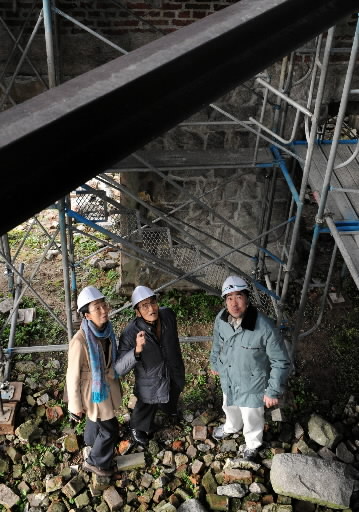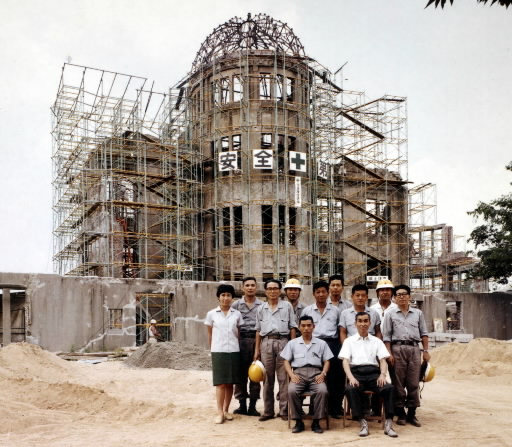A-Bomb Dome: Efforts to pass it down
Mar. 8, 2012
Hiroshima’s Futakuchi: Leader of first preservation project
by Yumi Kanazaki, Editorial Writer
Forty-five years ago the first preservation work on Hiroshima’s A-Bomb Dome was carried out under the supervision of Shojiro Futakuchi, who was then an employee of the Hiroshima office of Shimizu Corporation, a major construction company. Mr. Futakuchi, 91, a resident of Hiroshima, recently visited the dome, which is undergoing a structural soundness inspection to determine the state of its preservation. He is proud of his part in the effort to bring new life to the A-Bomb Dome, which was once at risk of collapsing. “I hope it will be preserved as a symbol of peace,” he said.
Inspection tour: Vivid memories
Repairs to last “100 years”: Entrusted with hopes
“The building had deteriorated much more than we thought, so the work was difficult,” recalled Mr. Futakuchi as he walked around his former worksite accompanied by his daughter Tomie, 62, and Tetsuji Yamaguchi, 42, a chief engineer for the city. “When holes were drilled the building shook, so I hurriedly yelled ‘Stop!’” Mr. Futakuchi told them as he pointed to an exterior wall.
In 1967, 22 years after the atomic bombing, Mr. Futakuchi was put in charge of overseeing the “big rush job,” which was to be completed in a mere three months. He led the project and served as the intermediary between the city, the panel of experts that had decided on the plan for the work, and the workmen.
Cracks in the walls and gaps between the bricks were filled with a resin adhesive, and a steel framework was installed throughout the dome’s interior for reinforcement. Steel supports were erected around the walls, and work progressed as the building was stabilized. Skilled workmen from around the country were brought together, and a chemical company developed a new adhesive for the project. “‘Don’t drop even one brick’ was our watchword, because we couldn’t have our preservation work turn out to be demolition work,” Futakuchi said. Adhesive was applied in approximately 10,000 spots.
“The A-bomb Dome is in the state it’s in today because Mr. Futakuchi and his team did a really good job,” said Mr. Yamaguchi. Tomie, who was a college student at the time, took the lunches her mother made for her father to him at the worksite. “I realized that people from all walks of life were responsible for ensuring that the story of the bombing would be passed on,” she said. Tomie herself is involved in various activities such as concerts at which performers play a piano that survived the bombing.
Years ago public opinion was divided on whether to preserve the A-Bomb Dome or tear it down, and it was in danger of collapsing. A preservation campaign launched by the elementary, junior high, and senior high school students of the Hiroshima Paper Crane Club led to a fund-raising drive by the public and private sectors. The city provided 66 million of the funds that were collected toward the cost of preservation work. Approximately 400 million was raised for the second preservation project in 1989. The foundation that was established with the remainder of the funds pays for the structural soundness inspections that are conducted every three years.
Mr. Futakuchi provided technical guidance during the second preservation project. On February 29, when the latest structural soundness inspection was essentially complete, Mr. Futakuchi visited the dome for the first time since 2002, when he took a look at the work done during the third preservation project. “It must be tough for the city since the dome was designated a World Heritage Site and repairs were restricted,” he said. “Measures to prevent rainwater damage are critical, but if repairs continue to be made promptly, they should last for 100 years. I’d like them to work hard and pass the A-Bomb Dome on to future generations in its present state.”
A-Bomb Dome
The A-Bomb Dome was designated a UNESCO World Heritage Site in 1996. The building was erected in 1915 in downtown Hiroshima on the banks of the Motoyasu River as the Hiroshima Prefectural Commercial Exhibition Hall. Its name was changed to the Hiroshima Prefectural Industrial Promotion Hall in 1933. The site is 160 meters from the hypocenter of the atomic bombing. All 30 people inside the building at the time of the bombing are believed to have been killed instantly. In 1953 ownership of the building was transferred from the prefecture to the city, which did preservation work on the structure in 1967, 1989 and 2002. Since 1992 inspections of the dome’s structural soundness have been carried out every three years. The most recent inspection checked for the presence of cracks in the walls, corrosion of the structural steel and settling of the building. The findings will be reported to a panel of experts in the summer, and the panel will then determine whether or not preservation work is needed.
(Originally published on March 5, 2012)









